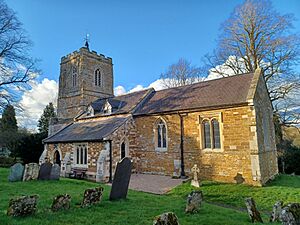St Peter's Church, Allexton facts for kids
Quick facts for kids St Peter's Church, Allexton |
|
|---|---|

St Peter's Church, Allexton, from the southeast
|
|
| Lua error in Module:Location_map at line 420: attempt to index field 'wikibase' (a nil value). | |
| OS grid reference | SK 817 004 |
| Location | Allexton, Leicestershire |
| Country | England |
| Denomination | Anglican |
| Website | Churches Conservation Trust |
| History | |
| Dedication | Saint Peter |
| Architecture | |
| Heritage designation | Grade II* |
| Designated | 29 December 1966 |
| Architectural type | Church |
| Style | Norman, Gothic |
| Groundbreaking | 12th century |
| Completed | 1863 |
| Specifications | |
| Materials | Stone, Welsh slate roofs |
St Peter's Church is an old and special church in Allexton, a village in Leicestershire, England. It's a very important building, listed as Grade II*, which means it's protected. The Churches Conservation Trust takes care of it. One of its coolest parts is the Norman north arcade, which is super old, from around 1160!
Contents
Church History
The oldest parts of St Peter's Church were built around the mid-1100s. This was a time when Norman architecture was popular in England. The tall tower was added much later, in the 1400s.
The side sections of the church, called aisles, were taken down in the 1500s. But don't worry, they were rebuilt in a big repair project between 1862 and 1863. This type of repair is often called a Victorian restoration. During this time, the old Norman north arcade was also fixed up because it was starting to fall apart.
Since April 27, 2000, the church has been looked after by the Churches Conservation Trust. This group helps to save important old churches for everyone to enjoy.
Church Design and Features
St Peter's Church is built from stone, and its roofs are made of slate from Wales. It has a main area called the nave, with side aisles on the north and south. There's also a chancel (the part where the altar is) with a porch on the north side, and a tower at the west end.
Outside the Church
The tower has two main levels and strong supports called buttresses on its west side. A small staircase sticks out from the tower on the south. The top of the tower has a battlemented edge, which looks like the top of a castle wall. On top of that is a small spire with a weathervane.
The windows in the north aisle have a special design called plate tracery. The chancel has two-light windows on both its north and south sides. The big window at the east end has Decorated tracery, which is a fancy pattern of stone bars. The south aisle has a doorway and a window with three sections. You can also see two small dormer windows sticking out of the roof above the south aisle. Next to the doorway, there are two old stone statues of lions!
Inside the Church
The Norman north arcade inside the church has two sections with round pillars. The arches above these pillars have cool zigzag patterns carved into them. The south arcade also has two sections, but its arches are pointed and rest on eight-sided pillars.
The font, where baptisms happen, is from the 1400s. On the south wall of the chancel, there's a piscina, which is a basin used for washing sacred vessels. One of the windows in the north aisle still has some medieval stained glass, which is very old. The stained glass in the east window was added in the 1800s.
The church has a set of four bells. The two oldest bells were made in 1597 and 1640. The other two were made in 1930 by a company called John Taylor & Co in Loughborough.
Churchyard Features
In the churchyard, you can find the tomb of Thomas Hotchkin, who passed away in 1774. It's a table-shaped tomb with decorative pillars at the corners. On top, there's a large pot-shaped decoration called an urn, which is decorated with leaves and flowers and has a flame-like top. This tomb is also a protected historical item, listed as Grade II. Thomas Hotchkin used to own a sugar plantation.
See also
- List of churches preserved by the Churches Conservation Trust in the English Midlands
- St Botolph's Church, Wardley, in neighbouring parish in Rutland, also in care of the CCT

